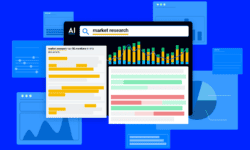Markets are relentlessly evolving at breakneck speed and generating massive amounts of information every day. Add in volatility brought on by geopolitical tensions and economic uncertainty and you start to portray how challenging it is to conduct market intelligence research today. This reality makes decision-making amongst organizations slow, even though the pace of business is continuously picking up.
According to an Orgvue Survey of Business Leaders, 65% of leaders say decision-making is more complex post-pandemic. This fact, coupled with the 89% of business leaders who think their organizations make decisions too slowly, reveals an industry-crossing need for speed and precision. Professionals require quick access to verified, impactful, and relevant information without sacrificing thoroughness.
Ultimately, intelligence that powers strategic decisions requires knowledge workers–and the wide range of professionals who conduct market research in their functions–to be agile.
It’s a problem that’s left many to question: where or how does one find the answers they need to make critical decisions?
And while many market intelligence tools position themselves as the solution to this problem, most options aren’t a perfect fit for every company. So how do business leaders decide which market intelligence tools are the right choice for their organization? Enter: the market intelligence maturity index.
The Current State of Market Intelligence
Today, 60% of large-company employees have difficulty getting the information they need—a troubling statistic considering that by 2025, global data creation is projected to grow to more than 180 zettabytes. Combine these facts with the larger picture of what research efforts within an organization look like: most teams operate with multiple platforms and subscriptions, siloed teams, and poor search and discovery. Together, this is a recipe for sluggish decision-making and market intelligence practices.
But for teams that are operating with sophisticated market intelligence practices, they reap the benefits of three main components:
- Connect more dots and increase productivity with cutting-edge tech like artificial intelligence (AI) and generative AI (genAI)
- Get answers faster by accessing insights not found anywhere else
- Leave nothing to chance and feel confident in the elimination of research blind spots
When it comes to tactically employing all three of the components above, it is important to level-set and know where your company is in terms of market intelligence maturity. Moreover, it’s crucial to understand the cost of relying on inefficient, ineffective intelligence retrieval methods.
Market Intelligence Maturity Challenges
When it becomes laborious to gather the right intelligence, professionals often rush to get what they need. But this consequently leads to a higher chance of research blindspots, blows to confident decision-making, flawed or biased outcomes. Eventually, key stakeholders lose trust in your intelligence, and internal alignment becomes a challenge.
In such a business environment, it becomes nearly impossible for you and your organization to:
- Be nimble, leaving you susceptible to the risk of negative impacts from big macro events (i.e. COVID-19 or recession)
- Outmaneuver in competitive situations, giving your competitors ample space to take the lead
- Be timely, thus causing you to be reactive and miss key opportunities
The bottom line: if your company is paralyzed (i.e. rigid, uncompetitive, and reactive), you’re in danger of losing market share and revenue to stronger and more agile competitors. Ultimately, when your market intelligence process fuels decision-paralysis, your company runs the risk of:
- Long lead times for seizing opportunity: Too much time is wasted searching for crucial pieces of information, which results from a lack of confidence in the intelligence itself. As more flawed intelligence is utilized, key stakeholders can become wary.
- Flawed and/or biased decisions: As a result of not having access to the right content at the right time, teams miss critical insights available in premium intelligence—information that contains valuable industry and market forecasts.
- Overall decline in market share and revenue: Without compelling intelligence, it becomes difficult to align key stakeholders around the correct course of action. Opportunities are missed, the competition starts to win against you, and as a result, you lose market share and revenue.
Making the right financial or mission-critical decision is often the difference between long-term success or irreversible consequences—ranging from lost customers to a tarnished reputation and missed financial opportunities.
Recent Gartner research illustrates a perfect storm of factors that demonstrate the challenges of making the right business decisions in today’s economic climate. As the volume of high-impact decisions has grown, consideration for their larger implications has diminished. Bad financial decisions cost firms up to 3% of profits. Adding salt to the wound, poor data quality plays a heavy role in the problem, costing organizations an average $12.9 million every year.
At the same time, the majority of decisions (65%) that need to be made are more complex than they were just two years ago.
Even companies that have prioritized market intelligence in the past must rethink their approach. Traditional processes no longer get the job done, and organizations that fail to advance their market intelligence capabilities risk being uninformed or worse, left behind.
The Costs of Ineffective Research Methods
The Content Gap
Challenge: You lack access to quality content and information, as valuable insights are difficult to parse, are locked behind paywalls, or are in disparate locations.
Cost: You have a high risk of decision-making error. Teams have to lean into low-value and public-facing sources that may be unreputable and often lack the necessary detail to explain the whole picture.
The AI Gap
Challenge: Without the help of artificial intelligence and genAI, gathering insights remains an entirely manual process. You overlook important company shifts and industry patterns.
Cost: There is never enough time for high-value tasks with a heavily manual and resource-intensive process. Consequently, teams over-index on research, missing key information and leaving little time for analysis and idea generation.
The Monitoring Gap
Challenge: Your current monitoring relies on a base of low value content, and/or you need to monitor several different resources, creating a deluge of information.
Cost: You lose your competitive advantage as you rely on manual methods, causing information overload, exhaustion, and research blindspots.
The Knowledge Gap
Challenge: You do not have the tools to support a powerful ongoing cadence of intelligence across the organization.
Cost: Market opportunities are regularly missed. Without any of the other three gaps closed, and a toolset to support the tracking and dissemination of intelligence, your organization misses critical business and market opportunities and becomes susceptible to losing market share.
A Solution to Market Intelligence Roadblocks
AlphaSense is a leading provider of market intelligence, including 10,000+ high-quality content sources from more than 1,500 leading research providers—all in a single platform. Analysts, researchers, and decision-makers in medtech can access exclusive research reports only found elsewhere in disparate locations and often behind expensive paywalls. With AlphaSense, companies can conduct comprehensive research that gives them a competitive edge with smarter, more confident decision-making.
Specific types of content you’ll find on the AlphaSense platform include:
- Company documents including event transcripts, FERC documents, global filings, press releases, company presentations, and ESG reports
- Over 1,500 research providers including Wall Street Insights®, a premier and exclusive equity research collection for corporate teams
- 40,000+ expert call transcripts with industry expert perspectives from customers, competitors, former employees, and partners
- Regulatory content and industry-specific publications
- Over 3,000 curated news sources and trade publications including industry news, and market news
Our AI search capabilities enable accurate, fast, and comprehensive qualitative and quantitative research, and can mine unstructured data for the most critical insights. These features include:
- Smart Summaries, our first generative AI feature, summarizes key insights from earnings calls for faster analysis
- Smart Synonyms™ technology that ensures you never miss a source important to your research
- Automated and customizable real-time alerts for tracking companies, industries, and potential investments
- Table export tools that support M&A workflows like target lists and due diligence
- AlphaSense Assistant (coming soon!), an AI-powered chatbot designed to answer your most pressing business questions, quickly and accurately
Curious to learn how you can assess your organization’s market intelligence maturity? Download our State of Market Intelligence: Market Maturity Index Report to discover where your company is falling short in its research efforts.




